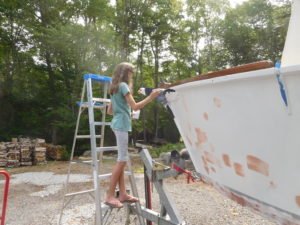
When I pitched the idea of a series of boatbuilding articles to Cruising World magazine fourteen years ago, I sent several samples and asked if they’d rather a slant toward technical details or if I should lean more in the direction of thoughts, dreams, and aspirations. “Dreams and aspirations, definitely,” they said, and since then, while framed around real events, I’ve written more about how I felt about those things than the things themselves. It’s worked out well, I guess, but what I’m leading up to is that it’s time to put aside the way I think and feel for now and focus on the technical. For those who only read this blog to be inspired or amused or perhaps disgusted (strange how your enemies sometimes follow you closer than your friends), please bear with the next few posts, and I assure you we’ll soon be back to the soulful drama of normal existence.
Plunging right in then, you’ll remember the tiny schooner from the last post. In the first few days after her arrival we saw that, having been cared for so well, she didn’t really need much in the way of repair—all she wanted was some fresh paint and some varnish here and there. We began, then, by sanding down the hull with 40-grit paper, followed by 80 grit. There were generations of paint on that hull, and we didn’t trouble to take them all off—we simply sanded until we found a solid surface to adhere to.
Now, I’m a big fan of 2-part paints and primers, and use them almost exclusively on fiberglass and carbon fiber projects, but for painting on wood I prefer a more traditional approach. Besides, the catalized paints are usually more toxic, and I’m involving the children in this. We chose Interlux Pre-kote for a primer. Just a simple, one-part, not-too-smelly primer that’s perfect for wooden boats. Once the hull was a uniform white, the dings you didn’t notice in the gray suddenly became apparent. I hadn’t meant to fair the hull, but I couldn’t resist doing one go-round with Bondo—Boat in a Can, they call the stuff around here. I could have kept smearing and sanding for weeks in the pursuit of perfection, but I told myself that a surface too fair would destroy all character, and besides, I hate fairing.
Luckily, that one smear of Bondo did the trick—after another coat of primer the tiny schooner had just the quantity of character required, and we could carry on to the next step. Like choosing a name for the boat, which we haven’t managed to yet, choosing a hull color was a matter of hot debate. Should the hull be a classy, shiny black? How strange would an eagle figurehead look on a fire-engine-red boat? Could an eagle fly against a field of pale green? Finally we decided that the only possible background for the eagle was blue. But what blue?
Several years ago I painted some oars with Kirby’s marine paint—it’s just a traditional one-part oil paint that flows nicely and proved surprisingly durable. The Kirby’s paint card—which was actual painted bits of paper pasted into a little book—didn’t have quite the shade desired, so taking a paint card from Home Depot and a child for company, I drove to Kirby’s paint shop in New Bedford.
It was George K. himself, who had sent a nice handwritten note along with the requested paint card, that mixed our paint. There was no magic computer scanner of the color, just a splash of this, a shake, a look, little dash of that, and voila! The perfect color for a tiny schooner. George called the formula “Zartman Blue” and filed it in the Rolodex on the counter. While there, he also made us a “Zartman Buff”—sort of a cream color for the decks, and sold us a can of McCloskey’s varnish.
Positively dripping with tradition, we returned home to paint.


With one child on each side rolling on paint with a short mohair “hotdog” roller, and me running from side to side tipping with a chip brush, it only took about 45 minutes to do the hull. And though the coverage was excellent we did another coat a day or so later. I simply can’t help myself: I’m a two coat sort of guy.
Meanwhile, the girls have freshened up the eagle figurehead with some black and white Rust-o-leum, and I did the mast tabernacles and caps with white Rust-o-leum as well. Since the tabernacles and spectacle iron are steel, I began with 2-part 545 primer, just to be sure of a good seal, but I probably won’t use it anywhere else.
Lastly for now, with all the hardware stripped off the masts, I’m taking the opportunity to lay on some varnish. The other brightwork on the boat can be done even while she’s in the water, but once the spars are up and rigged, that’s that. So before the weather sets in too cold, I’ll dip into that McCloskys and hope to get half a dozen coats or so before putting the hardware back on in the spring. That many coats may be just a dream, but I’m feeling good about it right now.






